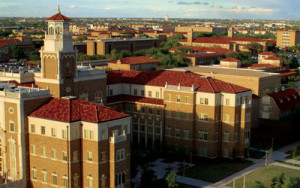
Bob Duncan is on a mission. It’s simple and complicated at the same time.
The Texas Tech University System chancellor believes Texas is too big a state to have just a single college of veterinary medicine. He wants to establish a second vet school and he wants it to be in Amarillo.
So, here’s the simplicity and complexity of the notion he is proposing.
The Texas Panhandle is at the epicenter of large animal care, given the region’s plethora of livestock in the form of cattle and horses. “The feedlots and dairies are clustered in West Texas, not on the Brazos (River),” he said, alluding to Texas A&M University’s dominance of veterinary medicine education. A&M has the sole such college in Texas, and Duncan wants to rid the Aggies of their vet school monopoly.
In a presentation today to the Rotary Club of Amarillo, Duncan made several key points. He pointed out that Texas Tech was created in 1923 as the result of a “big idea.” He believes the school of veterinary medicine is the university’s next major step forward.
Duncan said Texas has a shortage of veterinarians, 40 percent of whom are educated out of state.
The chancellor said Texas Tech has been consulting with veterinary medicine programs at Kansas State, Oklahoma State, Colorado State and University of California-Davis. He also noted that Amarillo is closer to the vet school campuses in Kansas, Oklahoma and Colorado than it is to College Station, home of Texas A&M University’s flagship campus.
But it gets complicated.
Duncan and his Tech team have been getting serious resistance from A&M, which is led by Chancellor John Sharp, who Duncan describes as a “fine chancellor” who’s also a friend. “We just disagree on this issue,” Duncan said of Sharp.
Sharp has been resisting Tech’s push for a school of veterinary medicine because he apparently believes there’s no need for a second such school in Texas, a state comprising 268,000 square miles and 28 million inhabitants. Indeed, Texas is the second-largest state geographically and second-most populous state in the nation. And we have just a single school of veterinary medicine?
I believe Chancellor Sharp has been bitten by the protectionist bug.
Duncan said he has no desire or intention to denigrate Texas A&M or its school of veterinary medicine. “A&M is considered one of the top 10 vet schools in the nation,” Duncan said, “but A&M cannot accept all the qualified applicants who want to be veterinarians.” He noted that most of the qualified Texas vet school applicants have to go out of state to obtain their doctorate in veterinary medicine.
Texas Tech has received $4.1 million from the Texas Legislature to develop a plan for a vet school in Amarillo, Duncan said, adding that Tech plans to present that plan to the 2019 Legislature, which convenes next January.
Tech plans to locate the campus next to it existing Texas Tech Health Sciences Center and School of Pharmacy campuses in west Amarillo.
But there’s a lot more money to raise, Duncan said, citing a $90 million goal from private, public and foundation sources. He said the Amarillo Economic Development Corporation has set aside $15 million in grant funds to assist in that fundraising effort.
“It’s a natural fit,” Duncan said of the vet school plan for the Texas Panhandle.
How confident is the chancellor of success? He didn’t specify.
I’ll just add that Duncan moved into the chancellor’s chair after a highly successful career in the Texas Senate. Many of his former Senate colleagues are still serving there, along with a smattering of those with whom he served in the Texas House. Moreover, Duncan also believes the Panhandle delegation — Sen. Kel Seliger, and Reps. John Smithee, Four Price and Ken King — all are lending their considerable influence to push the vet school over the finish line.
Duncan developed a high degree of respect as a legislator. I believe that respect transfers to the Texas Tech chancellor as he seeks legislative support for what he calls Tech’s next “big idea.”







